By Judith Elaine Halek
Photographs © Judith Elaine Halek

Women In Photography debuts an photographs and an article on
photographing water labors and births in the No. 8, Fall Issue,
October 1, 2001 Issue. The following is a rendition of the
article written by Judith Halek that appeared in this issue.
To view the website of Women in Photography, click here.
Archive 8 – WIPI News Article 3
| Documenting births has been an obsession of mine since 1987 when I assisted the first homebirth, waterbirth in New York City. Over the past fourteen years I have slipped in and out of one of the most intimate experiences known to life. I’ve had the privilege of documenting three separate environments; homes, hospitals and birth centers. My specialty is underwater birth. |
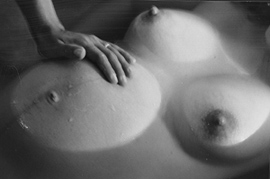
Waterbirth takes place when the baby is actually born from the womb of water inside the mother, to an extended womb of water, which could be a bathtub, a portable birthing pool, a jacuzzi, a water trough, or an ocean.
On my first contact with a couple, I give them a package of information and refer them to my website. After they have received the package and reviewed the site, we discuss what they like, what more they want and if whether there is a preference for a specific format, i.e., transparencies, and negatives, black/white, color.
Personally, I prefer to shoot with color negative because it offers more advanced emulsions. The additional color layers give better control in Photoshop. Black and white is the heart of photography, and from the purists point of view, film is superior to digital, yet, in the last three years technology has changed this. Today printing from a digital file with the special small gamut or monochrome black and white inks, creates a cutting edge print as acute as the traditional print from a darkroom.
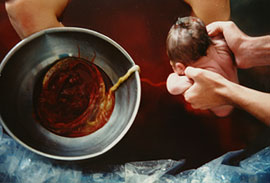
The first thing to establish is the due date. One can be on call
approximately three weeks before the due date and two weeks after, unless it will be a home birth where the post dates could last up to four or five weeks. We discuss whether the couple wants me to be at their home before they go to the hospital or birth center.
It’s imperative to have permission to photograph from the hospital or birth center. Put something in writing and submit it to the medical facility before hand. One doesn’t want to become an intruder and sometimes medical personnel can be security conscious. When parents create their birth plan, photographic permission ought to be included as part of the labor/birth.
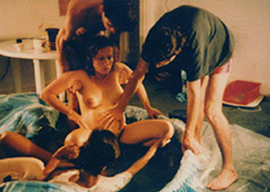
I work with the available light. Because of its invasive nature, I rarely use a strobe. I find available lighting creates a truer, softer,
journalistic reflection. I work with the fastest film for the camera:
Ilford and T-Max 400 and 800 for black and white and Fuji color (I find the skin tones are truer with Fuji). Sometimes I’ll be creative and shoot 1600 and 3200 when I’m at a home where candles are the only light source. I then utilize a monopod.I take anywhere between 5-8 rolls of film. I participate quietly in the labor and birth dance by making myself as inconspicuous as possible and shoot further away rather than close up. I work with the Canon EOS, SLR system; two cameras at a time with the Canon Elf as a third back up if we are transferring to the hospital or birth center. I use a EF 50mm f1:4 and EF 70-200 f1.2.8 lenses. I advise taking along a wide-angle lens such as a
21mm or 28mm for the confined areas.
When shooting, it1s important to focus on the details. Focus on becoming a Zen photographer and capture tender moments of father comforting mother, a gentle touch on a belly, a reflection in a mirror, a flower floating in water.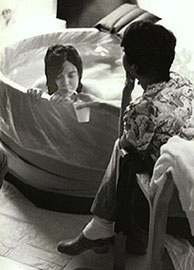 If you are fortunate enough to be invited into the OR in a hospital,
If you are fortunate enough to be invited into the OR in a hospital,
you’ll wear their sterile gowns. Pay attention to where you can and cannot be, and don’t touch anything! Take a small fanny pack for your film. In a birth center you can wear comfortable clothing to move around in, climb on top of tables, beds, chairs, or edges of the tub. A home birth environment is the most relaxed. Wear clean clothes, shoes that slip on and off easily, take time to use the bathroom, eat and hydrate yourself with something other than caffeine.Labors and births can take from 25 minutes to 18-20 hours. Patience and vigilance are the keys. It’s like covering a sporting event. You have no idea what’s going to happen minute to minute. Conserve your energy by breathing in such a way as to stay in a calm, neutral state, both mentally and physically. Most importantly, enjoy… the miraculous experience.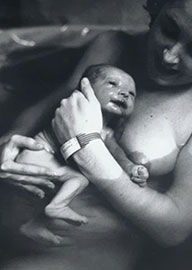
Judith Halek is the director of Birth Balance, the east coast resource center for under water birth. Judith is now in the process of moving her 15 years of photography out to the public. She has been published in numerous birth journals such as Midwifery Today, The Journal of Perinatal Education an ASPO/LAMAZE Publication as well as New York Magazine. She will be debuting her first solo show at a prestigious birth center in New York City this winter.
Her website is www.birthbalance.com
Her email is Judith@BirthBalance.com
Phone and Fax: 212-222-4349
*Judith Halek is among the photographers of
WIPI’s 20th Anniversary International Tea Time exhibit
